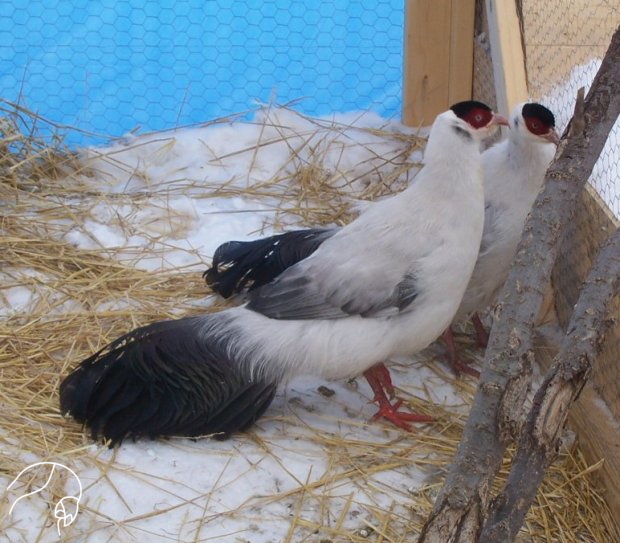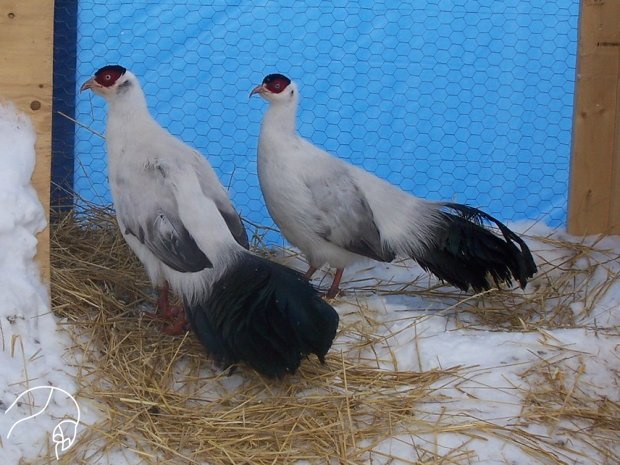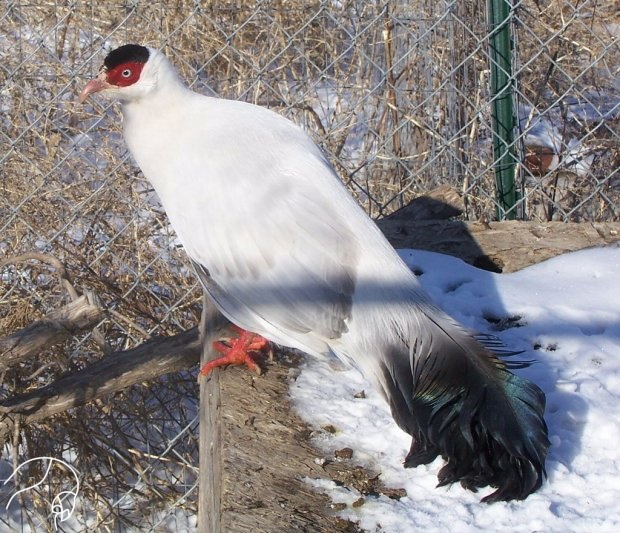White Eared-Pheasant (Crossoptilon crossoptilon)
Called Eared-Pheasants due to the tufts of feathers on the sides of their head, the White Eared-Pheasant is a unique species native to mountains of southern China.




Scientific classification: Kingdom Animalia, Phylum Chordata, Class Aves, Order Galliformes, Family: Phasianidae, Genus: Crossoptilon, Species: Crossoptilon crossoptilon
Range: China, from southeastern Tibet and western Szechuan, southern Qinghai, northwestern Yunnan.
Subspecies: There are four subspecies generally recognized, their geographical/common names and variations: Szechuan C. c. crossopitlon - pure white chin, rest of body off-white, wing coverts tinged with gray; primaries dark gray to brown; Dolan's C. c. dolani - ashy-gray overall with a white belly; wings are pale gray; Tibetan or Drouyni C. c. drouyni - whitest of the races, there is some light gray on the mantle, wings are white; Yunnan C. c. lichiangense - much like crossopitlon, but wings are lighter gray.
Habitat: Rocky hillsides in coniferous forests, also in mixed forests in summer to the snow line.
Status in Wild: Listed by IUCN as Near Threatened, habitat loss and hunting has taken toll in many areas of range and the population is decreasing rapidly.
Aviculture: Like all the species of Crossoptilon, the White-Eared Pheasant can become quite tame in the aviary, often greeting keepers and begging for hand out. White Eared-Pheasants are a mountainous species that do best cooler regions, in warmer regions, please make sure there is ample shade or cool zone for the birds. They have a large bill that they use for digging roots and tubers in the wild, so will dig into any available soil in an aviary. A rocky substrate with good drainage is recommended for the aviary floor. Adding boulders and features help in created a natural habitat, but planting could be a challenge as they will try to dig around the roots of the plant! Confiers do best and placing them in a pot with a wire guard may save the roots.
The breeding season is in late spring and males can sometimes be aggressive towards the female. Make sure there is cover and perching available for her to escape his advances. The female will lay her clutch of 4 to 7 eggs under cover and she will also slightly bury the eggs with leaves or debris until the clutch is complete. Incubation lasts roughly 25 days and is done solely by the female.
With a declining wild population, cooperative captive breeding programs are recommended.
Interesting Facts: Tibetan Buddhist monks protect this species and other birds on their monasteries in western Sichuan. At some monasteries, the wild pheasants have become quite tame when fed by the monks. The name Crossoptilon is from Greek origin for "fringe-feather".
- All About Birds - A Conservationist in Monk’s Robes: Gen Tashi Sangpo, the Bird Lama
- White Eared-Pheasant - BirdLife International Factsheet
- White Eared-Pheasant - eBird
- White Eared-Pheasant - gbwf.org
- White Eared-Pheasant - iNaturalist
External Links
The beauty and genius of a work of art may be reconceived, though its first material expression be destroyed; a vanished harmony may yet again inspire the composer, but when the last individual of a race of living things breathes no more, another heaven and another earth must pass before such a one can be again. - William Beebe, 1906
Animal Wonders
We depend on our programs & donations to help fund the care and housing for our animals, most of which are either rescues or surrenders. We seem to be always taking in new animals that need a home or different situation, their care adds up. If you would like to help support Animal Wonders, it would be greatly appreciated. We are always in need of donations, caging material, lumber, crates, aquariums, straw, & newspapers.
Contact
Animal Wonders,LLC
Address : 405 W 10th St, Holden, MO 64040
E-mail : info@animalwonders.net
Phone : 816-807-4748

